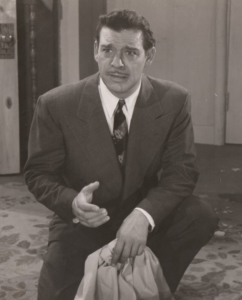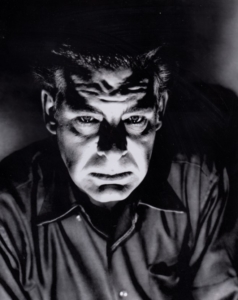
A WEREWOLF REMEMBERS
The Testament of Lawrence Stewart Talbot
PREFACE
In the early months of 1948, the express office of La Mirada, Florida received some odd items. In February, two large crates arrived, addressed to a local tourist attraction, “McDougal’s House of Horrors.” The crates were promptly delivered to McDougal’s, and their contents were just as promptly stolen. More on them later. In March came a steamer trunk addressed to “Lawrence Stewart Talbot.” Steamer trunks are now rarely seen, but in the 1940s and well before, many people who traveled extensively—entertainers, salesmen, and men of unclear intents and indefinite destinations like Lawrence Talbot—owned them.
Talbot left instructions at the express office to forward his trunk to the La Mirada Beach Apartments, where he leased furnished rooms. Talbot paid in advance for the transfer. When the trunk arrived, the rooming house owner had not seen his strange tenant for some weeks, and deposited the trunk in Talbot’s apartment. Talbot never returned to the rooming house. As best as I can determine, Talbot was never seen again. The landlord put the trunk in his storage room, where he stowed all items left by his tenants. There the trunk and other items Talbot left behind stayed for almost 30 years.
 That landlord was my Uncle Joe. Joe usually did not hold on to left-behinds for so long, but Talbot somehow impressed him. No small feat, for Uncle Joe routinely dealt with some pretty rough characters. During the one night that Talbot is known to have spent in his rooms, he thoroughly trashed them. He smashed furniture, and tore into upholstery. Talbot paid Joe in cash the next morning for the damage, paid two month’s rent in advance, and paid extra to have his room made habitable within a few hours.
That landlord was my Uncle Joe. Joe usually did not hold on to left-behinds for so long, but Talbot somehow impressed him. No small feat, for Uncle Joe routinely dealt with some pretty rough characters. During the one night that Talbot is known to have spent in his rooms, he thoroughly trashed them. He smashed furniture, and tore into upholstery. Talbot paid Joe in cash the next morning for the damage, paid two month’s rent in advance, and paid extra to have his room made habitable within a few hours.
Uncle Joe himself could be pretty formidable. During my childhood, when most of the family still lived in New Jersey, I was always a little afraid of him when he visited. Like a lot of the Italians in the old neighborhood who really scared me, Joe stood only a little more than 5 feet, about a foot shorter than Lawrence Talbot, who was large and well built. Joe had a force of character that is hard to describe. I mention that only because I suspect Joe sensed such a force in Talbot. Uncle Joe never forgot Talbot, and never discarded the steamer trunk.
* * *
The trunk was still in storage when Joe passed away. One of Joe’s sons, who knew nothing about the old trunk, snapped its lock, and saw that it contained mainly notebooks and papers. He left it there until the family sold the apartment house.
The trunk and Talbot’s other effects passed to me. I am as close as my family has to a genealogist. My cousin Anthony had no real idea where the trunk came from. He saw that it contained some sort of personal history, perhaps some record of the family. I was then living in Dallas, Texas, and he sent the trunk to me there. Anthony also sent some boxes of old records from the apartment house. When my research into Lawrence Talbot began in earnest, these old logs of who-rented-what-and-when proved invaluable in tracking his time in La Mirada. So did the small box of Talbot’s effects, which included a journal of his doings for the last known week of his life.
As genealogists know, every attic has a legendary trunk with the complete family history back to Adam & Eve. And every genealogist knows that, once opened, the trunk is a big disappointment. But hope springs eternal, and I read the contents expecting to add a branch or two to the family tree, and hoping to dig its roots a bit deeper.
 Instead, I found the writings of a strange man and an incredible life. My first impression was that Talbot suffered terrible delusions, as well as crippling bouts of depression, and perhaps paranoia, for Talbot spent his last months travelling Europe and finally the United States hunting down what he himself described as “monsters.” Talbot thought himself a monster that could not be destroyed and believed that he himself had committed countless murders. The horrible memories or delusions weighed heavily on his conscience, but did not deter him from committing—or thinking he committed—more. In his mind, he killed about once a month.
Instead, I found the writings of a strange man and an incredible life. My first impression was that Talbot suffered terrible delusions, as well as crippling bouts of depression, and perhaps paranoia, for Talbot spent his last months travelling Europe and finally the United States hunting down what he himself described as “monsters.” Talbot thought himself a monster that could not be destroyed and believed that he himself had committed countless murders. The horrible memories or delusions weighed heavily on his conscience, but did not deter him from committing—or thinking he committed—more. In his mind, he killed about once a month.
Incredible the notebooks may be, but my many years of researching Talbot’s life have uncovered no evidence that contradict his tales, and much that confirms them. Grisly murders and attacks occurred in all the places that Talbot claims to have lived. Of course, any world-class delusional concocts his fantasies consistent with any provable facts.
I have had ample opportunity to investigate Talbot. My career allowed me to live near or visit sites of Talbot’s adventures: the United Kingdom, Central Europe and of course America, my home country and Talbot’s adopted one. I found plenty of time to delve into local archives and records, and have been helped immeasurably by the curators of the Talbot Museum & Archive in Llanwelly, Wales. More on Llanwelly later. I have often stumbled on minute facts that Talbot could not have possibly known, and always the arcane tidbits support his accounts.
* * *
Talbot’s journals can be divided into two parts. The part that I call his Testament—the narrative of his life—is well organized and concise. These sections I reproduce verbatim. Between them, I include “Editor’s Inserts,” which give context for Talbot’s tale, and bring in my own researches that largely support his narrative. The Editor’s Inserts include the history of his family, of people and places that figure in his tale. The reader may skip these, if so inclined.
Talbot also writes on various topics in an almost stream-of-consciousness fashion. He believed that he was followed through his life—sometimes for decades—by a few people who appeared in different guises and identities. He also writes of supernatural curses and beings, and of a strange netherworld between life and death.
His torment centered on the Moon (I capitalize the word because Talbot in his journals always does). Page after page of his notebooks tell of lunar phases and eclipses, on when the Moon is closest to the Earth, and the Earth is closest to the Sun. Not exciting reading. I allude to these writings in the Editor’s Inserts, but have not included these sometimes lengthy passages in the text that follows. Talbot’s original journals, complete and unedited, along with his steamer trunk and its contents are now in the holdings of the Talbot Museum & Archive.
Talbot’s knowledge of the motions of the Earth and the Moon relative to each other and to the Sun, the Sun’s changes in brightness, and the positions of the planets was exceptional. Even in our age of the Internet, tracking all these motions on a daily basis is not easy, but Talbot did so by only watching the skies. Or did he, as he believed, simply “feel” what was going on in the heavens? However he did so, he may have been spot on. As best as the dates in Talbot’s records allow, I have compared his “feelings” with actual celestial positions and solar activity, and always they correlate.
* * *
Two things about Talbot’s life I cannot reconcile.
In his own account—and records bear him out—he was born 1883, and vanished 65 years later in 1948. Yet, the last photos of him, taken a day before he disappeared in February 1948, show a man in his 30s or 40s. Talbot himself has an explanation, but, dear reader, you will have to wait and decide for yourself as Talbot tells his tale.
 The other irreconcilable is simply money. He would live for long periods in apparent dire poverty, and then come up with the cash for hotel rooms, train tickets, and such. Frequently, he tells of his skill in card games, and perhaps used his luck at the gaming table more than he cares to mention. After 1946, he tapped into an inheritance that supported him in his last years, but before then he had no known means of income.
The other irreconcilable is simply money. He would live for long periods in apparent dire poverty, and then come up with the cash for hotel rooms, train tickets, and such. Frequently, he tells of his skill in card games, and perhaps used his luck at the gaming table more than he cares to mention. After 1946, he tapped into an inheritance that supported him in his last years, but before then he had no known means of income.
Maybe Talbot was a good gambler, who could “feel” a man’s luck as he claimed that he could “feel” the heavens above. Maybe astrology is not nonsense: a sense for the stars and planets can, in a world of flesh and blood, translate to treasure. My Uncle Joe, no stranger to games of chance, knew gamblers well. Sensing an exceptional one in Talbot might explain Joe’s respect and rapport with a man with whom he spoke briefly only twice.
* * *
The prime contents of Talbot’s trunk are a stack of journals, written between February 1946 and February 1948. These, with the partially-filled journal recording Talbot’s last thoughts and doings before he vanished, are his tale of his life.
The first journals deal with Talbot’s life before 1946. Though these contain accounts of gruesome deaths and morbid adventures, they have an upbeat tone, as if they were heading towards a happy ending. Only a few months into his writings, the tempo changes, and the depression that plagued Talbot through much of his life dominates his writings.
When his state of mind allowed, Talbot could be a lucid and engaging writer, and the tale of his life is quite readable. As depression overtook him, he veers from his life story to those strange diversions: discourses on the Moon and the Sun, and his belief that he is being followed and that people from his past are returning for vengeance. Speculations on his family seem most important to him. Talbot sometimes seems obsessed with his family and his place in it. The few photos in his trunk are of family members. His whole tale may be nothing more than his fitting every event and person that crossed in his path into his family drama.
If so, he fits the real world into his world with cunning and precision. After four decades of digging into the facts, I cannot find one that contradicts him.

